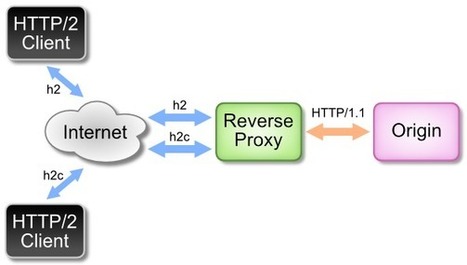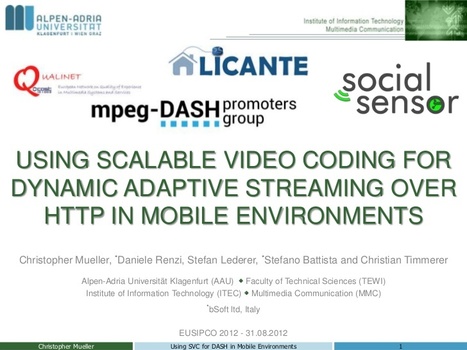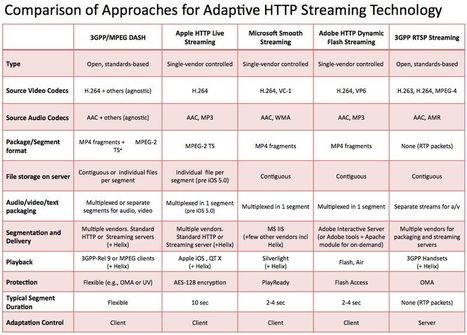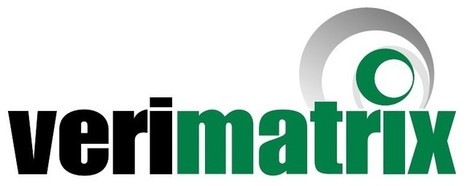 Your new post is loading...
 Your new post is loading...
We are pleased to announce the launch of our Adaptive Media Streaming over HTTP/2 trial. We are inviting you to participate in order to help us gather important data.
The experimental HTTP version 2 protocol promises to improve the web browsing experience but what does it mean for HTTP-based media streaming technologies such as MPEG-DASH?
It's all about DASH: Adoption is moving at a rapid pace, as industry insiders see a strong need to get DASH implemented in the field in the coming year. The Pantos spec, as it is known in the industry, is a series of working drafts for HLS submitted by two Apple employees as an information draft for the Internet Engineering Task Force. As of the time of this article, the Pantos spec is currently at informational version 10. Much has changed between the early versions and the most recent v10 draft, but one constant remains: HLS is based on the MPEG-2 Transport Streams (M2TS), has been in use for almost 2 decades, and is deployed widely for varied broadcast and physical media delivery solutions. In that time frame, however, little has changed for basic M2TS transport stream capabilities. For instance, M2TS still lacks an integrated solution for digital rights management (DRM). As such, all HLS versions cannot use "plain vanilla" M2TS, and even the modified M2TS used by Apple lacks timed-text or closed-captioning features found in more recent fragmented elementary stream streaming formats. Yet Apple has been making strides in addressing the shortcomings of both M2TS and the early versions of HLS: In recent drafts, the HLS informational draft allows for the use of elementary streams, which are segmented at the time of demand rather than beforehand. This use of elementary streams means that one Achilles' heel of HLS -- the need to store thousands, tens of thousands, or hundreds of thousands of small segments of long-form streaming content -- is now eliminated. Google, with its Android mobile operating system platform, has adopted HLS for Android OS 4. Some enterprising companies have even gone back and created HLS playback for earlier versions of Android OS-based devices.
Click here to edit the content...
"Dynamic Adaptive Streaming over HTTP (DASH) is a convenient approach to transfer videos in an adaptive and dynamic way to the user. As a consequence, this system provides high bandwidth flexibility and is especially suitable for mobile use cases where the bandwidth variations are tremendous. In this paper we have integrated the Scalable Video Coding (SVC) extensions of the Advanced Video Coding (AVC) standard into the recently ratified MPEG-DASH standard."
NAB 2012 closed its doors two weeks ago, so it’s a good time to draw an appraisal on various themes concerning OTT issues, and especially premium OTT issues, that have been handled through industry technology offer during the tradeshow. Here we’ll go from production to distribution and examine the salient NAB facts and products, at least the ones which have a potential influence on OTT workflows evolution in the coming months (or years ?).
The term adaptive streaming refers to technologies that encode multiple instances of a live or on-demand stream and switch adaptively among those streams to deliver the optimal experience to each viewer, taking into account both delivery bandwidth and playback horsepower. Producing for adaptive streaming involves two discrete analyses: how to choose the optimal number of streams and their configurations and how to customize the encoding parameters of the various streams to operate within each adaptive streaming technology. This article will explore both analyses.
In a decade or so down the line, experts looking back likely will say that 2012 was the year cable operators and the rest of the telecommunications industry pivoted from basic “get it out there” multiscreen platforms to those that work with a far higher level of precision and efficiency.
That’s the plan, at least. What happens remains to be seen. What is clear is that the industry is poised to take several important steps beyond the “one off” catch-as-catch-can approach that has dominated to date. “The year 2011 saw most — if not all — the major service providers world-wide investigating adaptive streaming, ranging from lab investigations to highly publicized deployments,” wrote Yuval Fisher, chief technology officer of RGB Networks in response to emailed questions. “The market has matured quickly, with operators’ expectations quickly rising from the initial ‘help me just see how this works’ to ‘I need high video quality, high-availability equipment.’”
Consistent multi-platform audio and video content delivery presents an ongoing challenge for broadcasters. Explosive smartphone and tablet growth on varying operating systems —Android, Apple iOS, or Windows Phone—threatens to create a user-experience divide between users on mobile devices, at the desktop or in the living room. Tim Siglin's white paper explores fragmented MP4 files (fMP4) and considers whether the fMP4 format can replace legacy file formats. Tim's blog page : http://workflowed.blogspot.com/2011/11/why-is-mpeg-dash-so-important.html White-paper : http://184.168.176.117/reports-public/Adobe/20111116-fMP4-Adobe-Microsoft.pdf
STMicroelectronics and Fraunhofer Heinrich Hertz Institute (HHI) today unveiled the industry’s first 3D video receiver based on the new MPEG-DASH standard for dynamic and adaptive HTTP streaming. The fully working prototype developed within the EU-funded COAST (Content Aware Searching and Streaming) project is being demonstrated at the Networked and Electronic Media (NEM) Summitin Torino, Italy on 27-29 September 2011. HTTP streaming enables high-quality video delivery over IP to connected TV sets, set-top boxes and mobile terminals. Recently released by the 3GPP and MPEG groups, Dynamic Adaptive Streaming over HTTP (DASH) aims to simplify the deployment of broadband video streaming services across different network infrastructures and end devices, replacing the multitude of proprietary HTTP streaming protocols with one open, standardized solution. DASH defines formats for content preparation and tools for fast and efficient content adaptation. It supports trick modes, multi-language subtitles and audio tracks, ad insertion and multiple digital rights management technologies aimed at protecting content, and works with standard web-server and cache technologies.
On today's StreamingMedia.com webinar about Adaptive Streaming & HTTP Delivery, RealNetworks shared the below slide featuring a nice chart that breaks out some of the differences and features from Apple, Microsoft and Adobe. Access to the webinar here : http://bit.ly/qpMVmE
An updated presentation by Christian Timmerer and Christopher Müller.
|
There is hope on the horizon. MPEG-DASH exists as an open alternative to these closed standards. Two of the three companies with proprietary closed standards have been actively involved in the formation and promotion of DASH. These efforts have been clearly successful, as DASH delivery of content is becoming more and more prevalent – for example, Netflix, Hulu and YouTube have all released versions of their content via DASH delivery. Through the efforts of Browser manufacturers, Media Source Extensions (another open standard), have become available in many browsers allowing delivery of DASH content without any additional plugins required. Unfortunately, HLS remains the most common delivery format in the US, and Apple (the author/owner of HLS) has shown no interest in supporting MSE in their browser. A tipping point is clearly on the way, which will see a massive growth in DASH delivery. Eventually Apple will be forced to embrace the current open standard, or risk losing content which has made their platform so appealing. The irony of course is that Apple has done so much marketing touting themselves as leaders of the “open web” movement, and they are the long holdout stalling the success of this open standard.
Intertrust Technologies Corporation today released Wasabi Express, a standards-based next generation DRM platform for mobile and desktop applications. Wasabi Express together with the Company’s DRM Cloud Services provides a single solution for service providers that want to distribute content using a Marlin DRM-compliant media player. Service providers, technology solutions providers and developers using Wasabi Express will have access to technologies that enable them to implement new content distribution business models for delivering over-the-top content to mobile and PC platforms. Wasabi Express offers extensive support for download and adaptive streaming media distribution models (including MPEG-DASH and HLS). It also enables content portability and compatibility with other Marlin clients and services. Wasabi Express is protected by tamper resistance technology from Intertrust’s whiteCryption subsidiary. Additional details on Wasabi Express are available at: http://www.intertrust.com/solutions/wasabi_express
SPB TV Solution empowers 3D and regular 2D video formats encoding and streaming in multiple quality options, from mobile to HD, to provide the brightest user experience on a small phone as well as on a big modern TV. Due to anaglyph and side-by-side technology support, 3D video can be delivered to both 3D-enabled and usual screens. SPB TV pays great attention to the stability and quality of the video playback in any network capabilities, so its solutions support all major technologies of adaptive streaming: RTSP, Apple HTTP Live Streaming (HLS), Microsoft Smooth Streaming, Adobe HTTP Dynamic Streaming, as well as MPEG-DASH - a new unified adaptive bitrate standard developed by ISO.
The HbbTV (Hybrid Broadcast Broadband TV) consortium has announced the publication of version 1.5 of its hybrid TV specification. Building on existing standards and web technologies, the HbbTV specification provides the features and functionality required to deliver feature rich broadcast and internet TV services. Version 1.5 of the HbbTV specification notably introduces support for HTTP adaptive streaming based on the recently published MPEG-DASH specification, improving the perceived quality of video presentation on busy or slow Internet connections. It also enables content providers to protect DASH delivered content with potentially multiple DRM technologies based on the MPEG CENC specification, improving efficiency in markets where more than one DRM technology will be used. Version 1.5 significantly enhances access to broadcast TV schedule information, enabling operators to produce full seven-day electronic programme guides as HbbTV applications that can be deployed across all HbbTV receivers to provide a consistent user experience. The latest advances are based on activity within the HD Forum in France as part of the development of the TNT 2.0 specification
The future of CDN-delivered video is cacheable, HTTP streaming, with MPEG DASH ultimately taking over, says Highwinds' Chris Bray.
2012MMSys has announced the selected papers that will be presentend next year. The list is quite impressive and provides numerous R&D insights on how DASH and HTTP streaming in general can be optimized. Let's book our seats for great topics like : - Shaping HTTP adaptive streams for a better user experience - QDASH: A QoE-aware DASH system - Adaptive Scalable Video Streaming in Wireless Networks - Synchronized Delivery of Multimedia Content over Uncoordinated Broadcast Broadband Networks - Quality Selection for Dynamic Adaptive Streaming over HTTP with Scalable Video Coding - Dynamic Adaptive Streaming over HTTP Dataset
One of the most popular features of modern Flash players is the ability to adapt the bitrate of the streamed video to the available bandwidth, also called HTTP adaptive streaming. HTML5 browsers (with the notable exception of Safari, which supports Live Streaming) do not yet suport this feature because it has not been standardised yet in a codec-independent manner. ISO/MPEG have developed the DASH specification, which may be applied in a codec-independent manner and therefore be a good option for HTML5. While there are several solutions for HTTP adaptive streaming of MPEG video, none has been released for WebM, nor a standard set that works across media formats. Experiments have been run in several frameworks for WebM to see how it can work in comparison to MPEG. This session gives the developers an opportunity to report on their experiences and to discuss how to move forward for standardisation across browsers and codecs.
The last thing digital video needs is new jargon that fuels another cycle of hype. So here’s the quick case for spotlighting hypertext transfer protocol (HTTP) video: In tech years, HTTP is not new, but ancient, or as old as the Internet; HTTP linked to video is proving to be a strong growth engine. The longer defense is that HTTP provides a hook for the “multi-screen” and “over-the-top” (OTT) themes that dominated IBC 2011. The key is that in contrast to IPTV-centric protocols, HTTP focuses on the client—on whatever device and at the end of whatever network—and its so-called GETs, or means of retrieving information or video from a network server. This protocol and its adaptive bit-rate (ABR) cousins have yet to conquer the world. In fact, a competing theme at IBC 2011 was “hybrid,” whose resurgence indicates “more longevity in broadcast,” said ADB VP Strategy Paul Bristow. Moreover, there were other categories of technology on display: advanced advertising, HD, 3D, Super Hi-Vision, content distribution networks (CDNs), conditional access (CA) and digital rights management (DRM) systems.
This part of ISO/IEC 23001 specifies formats for adaptive streaming delivery of MPEG media over HTTP. This International Standard is applicable to streaming services over the Internet.
This specification primarily defines two formats:
- The Media Presentation Description (MPD) describes a Media Presentation, i.e. a bounded or unbounded presentation of media content. In particular, it defines formats to announce resource identifiers for Segments and to provide the context for these identified resources within a Media Presentation. In the context of this specification, the resource identifiers are exclusively HTTP-URLs, i.e. URLs with a fixed scheme as defined in RFC 3986 of “http://” or “https://”. However, this specification additionally enables the restriction of these URLs by a byte range attribute.
- The Segment formats specify the formats of the entity body of the request response when issuing a HTTP GET request or a partial HTTP GET with the indicated byte range through HTTP/1.1 as defined in RFC 2616 to a resource identified in the MPD.
Initiative promises efficiency gains for multi-screen service operations.
|



 Your new post is loading...
Your new post is loading...













![SPB TV's "3D Video on 3 Screens" solution supports all ABR streaming protocols [PR] | Video Breakthroughs | Scoop.it](https://img.scoop.it/VsMI5yRgmCLYu155um0i1Dl72eJkfbmt4t8yenImKBVvK0kTmF0xjctABnaLJIm9)









